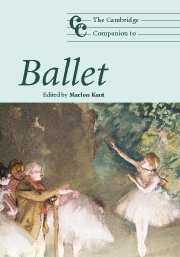Book contents
- Frontmatter
- Introduction
- Part I From the Renaissance to the baroque: royal power and worldly display
- Part II The eighteenth century: revolutions in technique and spirit
- Part III Romantic ballet: ballet is a woman
- 10 Romantic ballet in France: 1830–850
- 11 Deadly sylphs and decent mermaids: the women in the Danish romantic world of August Bournonville
- 12 The orchestra as translator: French nineteenth-century ballet
- 13 Russian ballet in the age of Petipa
- 14 Opening the door to a fairy-tale world: Tchaikovsky's ballet music
- 15 The romantic ballet and its critics: dance goes public
- 16 The soul of the shoe
- Part IV The twentieth century: tradition becomes modern
- Notes
- Bibliography and further reading
- Index of persons
- Index of ballets
- Subject index
- The Cambridge Companion to Music
16 - The soul of the shoe
from Part III - Romantic ballet: ballet is a woman
Published online by Cambridge University Press: 28 September 2011
- Frontmatter
- Introduction
- Part I From the Renaissance to the baroque: royal power and worldly display
- Part II The eighteenth century: revolutions in technique and spirit
- Part III Romantic ballet: ballet is a woman
- 10 Romantic ballet in France: 1830–850
- 11 Deadly sylphs and decent mermaids: the women in the Danish romantic world of August Bournonville
- 12 The orchestra as translator: French nineteenth-century ballet
- 13 Russian ballet in the age of Petipa
- 14 Opening the door to a fairy-tale world: Tchaikovsky's ballet music
- 15 The romantic ballet and its critics: dance goes public
- 16 The soul of the shoe
- Part IV The twentieth century: tradition becomes modern
- Notes
- Bibliography and further reading
- Index of persons
- Index of ballets
- Subject index
- The Cambridge Companion to Music
Summary
Ask any young woman on her way to a performance of Giselle or Sleeping Beauty what most clearly symbolises ballet and she will probably answer – the skirt and the pointe shoe. She will not quote sentences from the story and may recall only a few names of the characters. But after the performance she will remember the ballet costume of the female dancer. If she ever had ballet lessons she will reminisce about her first pointe shoes; she might still have them in the attic. Why this cult of the costume? Has ballet no message? Is it merely a flighty art form of beautiful lines, of flowing skirts and satin shoes?
The history of these two items of dress tell us exactly the opposite. The skirt and the point shoe represented a complete change in the nature of the ballet as an art form. They have not always been there. When they were introduced in the 1830s, roughly 180 years ago, they initiated a revolution in artistic values and a fundamental shift in the attitude towards women in public life.
How and why the tutu and the slipper achieved this pride of place in ballet will be explained in what follows. Less clear is why much ballet today still uses a dress code frozen in time.
- Type
- Chapter
- Information
- The Cambridge Companion to Ballet , pp. 184 - 198Publisher: Cambridge University PressPrint publication year: 2007
- 1
- Cited by

